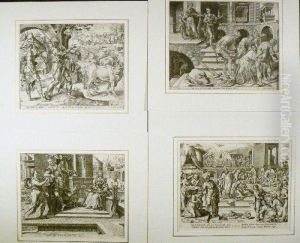Maarten Jacobsz Van Veen Meemskerk Paintings
Maarten van Heemskerk, born Maarten Jacobszoon van Veen, was a Dutch Renaissance painter and draughtsman known for his religious scenes, intricate compositions, and architectural studies. Born in 1498 in the small village of Heemskerk in the northern Netherlands, Maarten adopted the name of his hometown as part of his own. His early education in the arts remains somewhat obscure, but it is believed that he started his artistic training with Jan van Scorel, a prominent Dutch painter of the time who had a significant influence on Heemskerk's development.
Van Heemskerk's ambition and talent led him to travel. Around 1532, he embarked on a pilgrimage that would take him to the heart of the Italian Renaissance, Rome. There, he studied the works of the great masters, such as Michelangelo, Raphael, and others, whose influence is evident in his later work. His Roman sketches of ruins are of particular historical value; they provide insights into the state of the city's ancient architecture during the 16th century.
Returning to the Netherlands around 1537, Heemskerk began to incorporate Italianate elements into his works, thus contributing to the spread of Renaissance styles in Northern Europe. His paintings often depicted scenes from the Bible and classical mythology, rendered with a Mannerist flair typical of the late Renaissance. Heemskerk's work was characterized by dramatic compositions, a vivid use of color, and a certain grandeur that reflected his Italian influences.
Apart from religious and mythological scenes, Maarten van Heemskerk is also known for his portraits and a series of paintings of the Seven Wonders of the World, which were celebrated for their imaginative interpretation and detailed representation. Throughout his career, he cultivated a strong reputation and was highly regarded by his contemporaries.
Maarten van Heemskerk passed away in his hometown of Heemskerk in 1574. His legacy is preserved through his influence on Dutch art and his contributions to the Northern Renaissance, as well as through his surviving works, which can be found in museums and collections across the world.
